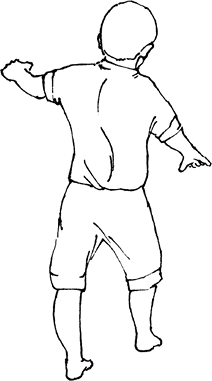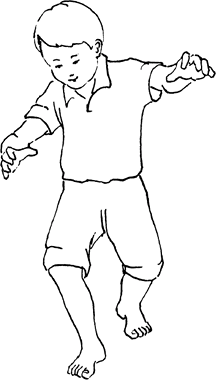Friedreich Ataxia
Editors: Frassica, Frank J.; Sponseller, Paul D.; Wilckens, John H.
Title: 5-Minute Orthopaedic Consult, 2nd Edition
Copyright ©2007 Lippincott Williams & Wilkins
> Table of Contents > Friedreich Ataxia
Friedreich Ataxia
Paul D. Sponseller MD
Description
-
Friedreich ataxia is an uncommon, heritable disorder causing progressive spinocerebellar degeneration (1,2).
-
Scoliosis, ataxia, and foot deformities are the most common findings (Fig. 1).
-
Systems affected: Central nervous system; Heart; Skeleton
-
Classification:
-
No subclassifications are used in Friedreich ataxia.
-
It is classified under the category spinocerebellar degeneration, and it is the most common example of this class.
-
Another disorder in this class is spinocerebellar ataxia.
-
-
Synonym: Spinocerebellar degeneration
Epidemiology
Incidence
Prevalence is ~1 per 50,000 persons (1).
Prevalence
-
It may become apparent anytime from 5–25 years of age.
-
Males and females are affected equally.
Risk Factors
The condition is more common in people of French Canadian descent (1).
Genetics
Transmission is autosomal recessive.
 |
|
Fig. 1. Scoliosis, cavovarus feet, and ataxia as seen in Friedreich ataxia.
|
Etiology
-
The cause is a defect in a gene for a protein, frataxin, found on chromosome 9 (1).
-
The pathogenesis of the findings is not well known.
-
Variations in characteristics of the
disease (e.g., age at onset and rate of progression) may be caused by
different mutations at one of the loci.
Associated Conditions
-
Diabetes mellitus
-
Cardiomyopathy
-
Scoliosis
-
Foot deformity
The diagnosis is made on a clinical basis, usually confirmed by a neurologist.
Signs and Symptoms
-
Common signs:
-
Ataxia
-
Wide-based gait
-
Weakness and loss of position sense in the lower extremities
-
Frequently, loss of upper extremity reflexes
-
-
Less common signs:
-
Pes cavus
-
Optic atrophy
-
Nystagmus is possible.
-
-
Symptoms:
-
Partial deafness, depression, loss of coordination, painful muscle spasms, and weakness
-
Symptoms of diabetes mellitus also may be related because of the increased coexistence of these disorders.
 Fig. 2. Ataxia and cavovarus feet in Friedreich ataxia.
Fig. 2. Ataxia and cavovarus feet in Friedreich ataxia.
-
Physical Exam
-
Examine heel-to-toe walking and finger-to-nose positioning (Fig. 2).
-
Look for the presence of increased kyphosis on routine standing.
-
Perform the forward-bend test for scoliosis.
-
Test upper and lower extremity reflexes.
-
Note the flexibility of the feet and the correctability of any deformity.
-
Test muscle strength (proximal muscles are affected earlier are than distal muscles).
-
The gluteus maximus is the 1st muscle to be affected clinically.
Tests
Lab
-
Creatine phosphokinase levels are normal.
-
Fasting serum glucose for diabetes mellitus should be obtained.
-
Other tests:
-
Electrocardiography should be performed
before surgery, with echocardiography as indicated, because of the
increased incidence of hypertrophic cardiomyopathy. -
Electromyography shows polyphasic potentials and mild slowing of nerve conduction velocity.
-
Imaging
-
Standing posteroanterior and lateral radiographs of the spine should be ordered when scoliosis and kyphosis are found.
-
Periodic monitoring then is indicated, even after maturity.
-
-
Foot radiographs may be indicated.
Differential Diagnosis
-
Cerebellar tumors
-
Chiari malformation
-
Muscular dystrophy
-
Spinal dysraphism (as a cause of scoliosis and foot deformity)
P.151
General Measures
-
Foot and spine deformities should be followed by an orthopaedic surgeon, even if surgery is not contemplated.
-
Brace treatment of scoliosis is appropriate for curves of 25–45° and may slow the rate of progression.
-
Stretching and night bracing may be helpful in preventing worsening of the foot deformities.
-
Walking should be maintained as long as possible.
Special Therapy
Physical Therapy
-
Therapy is essential, to keep up strength and skills after surgery.
-
Stretching of plantar fascia and ankle muscles help to prevent deformity.
Medication
-
No medical treatment currently is available.
-
If painful muscle spasms occur, baclofen or diazepam may be helpful.
Surgery
-
Scoliosis:
-
A cardiopulmonary evaluation is indicated preoperatively.
-
To prevent progressive decompensation of
the spine, posterior fusion and instrumentation with 2 contoured rods
is indicated for curves of >50°. -
If the curve is large, rigid, and unbalanced, an anterior release also may be indicated to increase the correctability (2–4).
-
Spinal cord monitoring may be more challenging and should include sensory and motor modalities.
-
Postoperative immobilization usually is unnecessary.
-
-
Cavovarus feet: Correction may include:
-
Plantar fasciotomy
-
Achilles tendon lengthening and transfer or lengthening of the PTT
-
Possible osteotomy
-
Disposition
Issues for Referral
A neurologist is the best specialist for coordinating the overall care of these patients.
Prognosis
-
If scoliosis develops before the patient is 15 years old, it most likely will become severe and require surgery.
-
Most affected individuals stop walking by 20–30 years of age and are wheelchair dependent.
-
Death usually occurs by the 4th or 5th decade; causes most often include pneumonia, aspiration, and cardiomyopathy.
Complications
-
Cardiomyopathy
-
Calluses or skin breakdown on the foot
-
Pneumonia
Patient Monitoring
-
This disease is progressive.
-
Walking distance and status of all physical findings should be monitored every 3–6 months.
-
Scoliosis, if present, should be checked every 6 months.
References
1. Cady RB, Bobechko WP. Incidence, natural history, and treatment of scoliosis in Friedreich’s ataxia. J Pediatr Orthop 1984;4:673–676.
2. Delatycki MB, Paris DBBP, Gardner RJM, et al. Clinical and genetic study of Friedreich ataxia in an Australian population. Am J Med Genet 1999;87: 168–174.
3. Labelle H, Tohme S, Duhaime M, et al. Natural history of scoliosis in Friedreich’s ataxia. J Bone Joint Surg 1986;68A:564–572.
4. Shapiro
F, Bresnan MJ. Orthopaedic management of childhood neuromuscular
disease. Part II: Peripheral neuropathies, Friedreich’s ataxia, and
arthrogryposis multiplex congenita. J Bone Joint Surg 1982;64A:949–953.
F, Bresnan MJ. Orthopaedic management of childhood neuromuscular
disease. Part II: Peripheral neuropathies, Friedreich’s ataxia, and
arthrogryposis multiplex congenita. J Bone Joint Surg 1982;64A:949–953.
Codes
ICD9-CM
334.0 Friedreich ataxia
Patient Teaching
-
Patients should be counseled about the
natural history of the disease, which consists of slow degeneration, so
they can plan appropriately. -
Patient support groups often are helpful.
-
Genetic counseling should be offered.
FAQ
Q: Will physical therapy help to restore coordination?
A: No. Coordination depends most on the progression of the disease.
